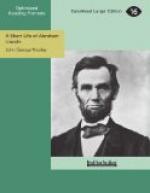=Lloyd, John M.=, keeps tavern at Surrattsville, Maryland, 536
=Logan, Stephen T.=, at Springfield, Illinois, 52;
law partnership with Lincoln, 70;
defeated for Congress, 91
="Long Nine,"= a power in Illinois legislature, 61
=Longstreet, James=, Confederate lieutenant-general,
besieges Burnside at Knoxville, 391;
retreats toward Virginia, 391;
reports conversation with Ord, 503;
in final defense of Richmond, 509
=Louisiana=, State of, military governor appointed
for, 419;
election for members of Congress, 422;
contest over slavery clause in new constitution,
422, 423;
election of State officers in, 425, 426;
adopts new constitution abolishing slavery,
426;
slavery in, throttled by public opinion,
473;
ratifies Thirteenth Amendment, 475
=Lovejoy, Elijah P.=, murder of, 46
=Lovell, Mansfield=, Confederate major-general,
evacuates New Orleans, 285;
sends men and guns to Vicksburg, 286
=Lyon, Nathaniel=, brigadier-general United States
Volunteers,
service in Missouri, 202-204;
killed at Wilson’s Creek, 234, 235
=Lyons, Richard Bickerton Pemell=, baron, afterward
earl,
British minister at Washington,
instructed to demand apology for Trent
affair, 246
=McClellan, George B.=, major-general, general-in-chief,
United States army, orders concerning
slaves, 221;
commissioned by Governor Dennison, 224;
his previous career, 224;
quick promotion of, 224;
successes in western Virginia, 224, 225;
ordered to Washington, 229;
his ambition, 249-251;
organizes Army of the Potomac, 250, 251;
his hallucinations, 251, 252;
quarrel with General Scott, 251, 252;
expresses contempt for the President,
252;
answer to President’s inquiry, 253;
illness of, 253;
instructions to Buell, 258-260;
unwilling to promote Halleck, 270;
attends council of war, 289;
explains plan of campaign to Stanton,
290;
letter to Stanton, 292;
revokes Hooker’s authority to cross
lower Potomac, 294;
council of his officers votes in favor
of water route, 295;
at gathering of officials to discuss news
of fight
between Monitor and Merrimac,
296;
occupies abandoned rebel position, 297;
calls council of corps commanders, 298;
relieved from command of all troops save
Army of the Potomac, 298;
arrives at Fortress Monroe, 299;
siege of Yorktown, 301;
his incapacity and hallucination, 302-304;
retreat to James River, 302;
letter to Stanton, 303;
protests against withdrawal of Army of
the Potomac, 309;
reaches Alexandria, 311;
suggests leaving Pope to his fate, 311;
telegram to Pope’s officers, 313;
in command of defenses of Washington,
313;
follows Lee into Maryland, 314;




